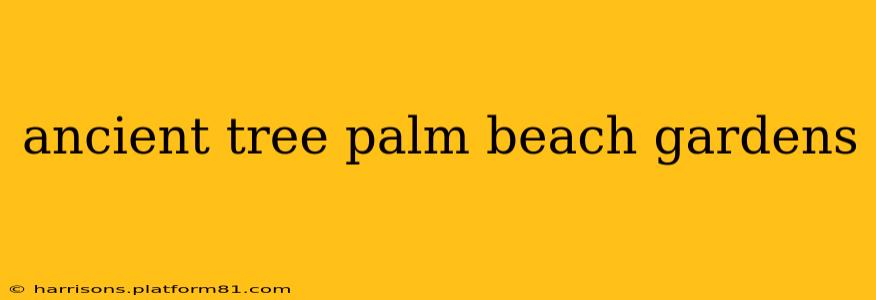Palm Beach Gardens, Florida, boasts a stunning landscape, and woven into its fabric are magnificent ancient trees, silent witnesses to the area's rich history and ecological evolution. These majestic specimens, often overlooked in the rush of daily life, offer a captivating glimpse into the past and a crucial role in the present-day ecosystem. This article delves into the fascinating world of ancient trees in Palm Beach Gardens, exploring their significance, identifying notable examples, and addressing common questions surrounding their preservation.
What Makes a Tree "Ancient"?
Before we explore specific examples, it's crucial to define what constitutes an "ancient tree." There's no single, universally accepted age threshold. However, trees generally considered ancient are typically hundreds of years old, sometimes exceeding several centuries. Their age is often determined through various methods, including dendrochronology (tree-ring dating), historical records, and expert assessment based on size, growth rate, and species. The term also implies a significant historical or ecological value, representing a connection to the past and a vital component of the local biodiversity.
Where Can I Find Ancient Trees in Palm Beach Gardens?
Unfortunately, a comprehensive, publicly accessible database detailing the precise locations of all ancient trees in Palm Beach Gardens doesn't exist. Many are located on private property, while others are situated within parks and preserves. The best approach to discovering these hidden gems is through exploring local parks, nature trails, and contacting the Palm Beach Gardens Parks and Recreation Department for information on significant trees within their jurisdiction. Remember to always respect private property and stay on designated trails.
What Types of Ancient Trees Are Common in Palm Beach Gardens?
Palm Beach Gardens' subtropical climate supports a diverse range of tree species, some of which are long-lived and potentially ancient. Common candidates include various oak species (like live oak), sabal palms, and possibly some cypress trees, depending on location and proximity to water sources. Identifying ancient trees requires expertise, and consulting with arborists or local botanical experts can be invaluable.
How Are Ancient Trees Protected in Palm Beach Gardens?
Preservation efforts for ancient trees in Palm Beach Gardens vary. Some are protected by local ordinances that regulate development and construction near significant trees. Others may fall under the purview of environmental conservation organizations working to preserve natural areas. Public awareness and responsible land management play a vital role in safeguarding these irreplaceable natural treasures.
What is the Significance of Preserving Ancient Trees?
Preserving ancient trees offers multiple benefits. Ecologically, they provide crucial habitats for wildlife, contribute to biodiversity, and help mitigate climate change by absorbing carbon dioxide. Historically, they serve as living links to the past, offering valuable insights into the region's ecological history and development. Furthermore, they enhance the aesthetic appeal of our communities, adding to the overall quality of life.
Are there any guided tours or walks that highlight ancient trees?
Currently, there aren't widely advertised guided tours specifically focused on ancient trees in Palm Beach Gardens. However, exploring local parks and nature trails independently can lead to discovering these magnificent specimens. Contacting the Palm Beach Gardens Parks and Recreation Department might reveal any upcoming events or initiatives that highlight local flora, potentially including ancient trees.
Conclusion:
The ancient trees of Palm Beach Gardens stand as silent sentinels, reminding us of the interconnectedness of time, nature, and community. While a comprehensive map of these living monuments may not yet exist, their presence enriches the landscape and emphasizes the importance of conservation efforts. By appreciating and protecting these remarkable trees, we ensure their continued contribution to the ecological and historical tapestry of Palm Beach Gardens for generations to come.
